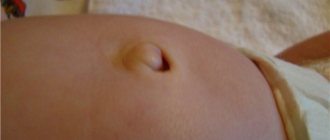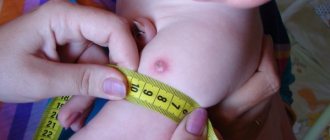Before I started writing the material, I read on mothers’ forums what is known about “stubble” and umbilical hernia in infants.
Here are some tips related to our topic today that grandmothers give to mothers:
“Our mother-in-law suggested that we take the child to the village from the bristles on his back so that the pig could step over him.”
“To avoid an umbilical hernia, you need to throw a diaper with poop on the roadway so that more cars can drive over it. Well, I say, go ahead and quit. The mother-in-law waited for the night and went, seriously.”
You can treat this advice from grandmothers with bewilderment, irony or a smile. However, the problem still exists. After all, when it is difficult to calm a child who is bursting into tears, then you are ready to do anything to ensure that the baby finally calms down and falls peacefully asleep.
So let's talk about bristles and umbilical hernia from a medical point of view.
Anatomical features of the peritoneum of a newborn
The muscle structure of a newborn baby's abdomen is very vulnerable, and any careless movement can lead to injury. The navel, immediately after birth, is connected to a part of the umbilical cord that has yet to dry out. The navel is one of the most vulnerable areas to infection.
Inside the anterior abdominal wall there is an umbilical ring that connects the baby to the placenta. At birth, she was cut off, leaving a small stump, which heals in 5-10 days if properly cared for. Over time, the stump is retracted into the abdominal cavity, leaving a small dimple on the outside.
If any malfunction occurs, the navel is formed sticking out. In some cases, this is due to the characteristics of the child’s body and the structure of the abdominal area; in other situations, it indicates dangerous processes.
When does a natural bulge appear?
Under natural conditions, a newborn's navel protrudes if the obstetrician bandages it too high. In this case, the baby will not feel any unpleasant symptoms: he behaves normally, there is no pain when palpating the navel, swelling and other bad signs do not appear. It is possible to use surgical methods to remove the bulge in the following cases:
- it interferes with dressing the child, which in the future can lead to mechanical injuries, ulcers, fistulas;
- the bulge prevents you from wearing panties, diapers, or trousers normally;
- in the future, this feature may become a serious aesthetic problem, especially in girls.
Navel restoration surgery can be easily performed in the first months of life without risk to the child’s health.
Umbilical hernia
Breastfed babies are susceptible to the appearance of a hernia in the umbilical hilum area. In this case, the navel of a newborn baby begins to stick out in the first year of life. A hernia occurs for the following reasons:
- weak abdominal muscles and umbilical ring;
- genetic factors;
- chemical, physical or infectious effects on the fetus during pregnancy;
- anomalies in the location of internal organs;
- defect or underdevelopment of the umbilical ring.
In most cases, a hernia becomes a congenital pathology. It can develop against the background of severe crying, coughing, colic and constipation, excessive gas formation, and disorders such as malnutrition or rickets.
An umbilical hernia can be recognized by the following signs:
- the protrusion is located directly in the navel or next to it, it is soft to the touch, moves back, is movable;
- when pinched, pain appears, the tumor site turns red and swells;
- When you feel a strangulated hernia, it is no longer possible to correct it; this causes severe discomfort to the child.
Infringement of a hernia is dangerous due to tissue necrosis, intestinal perforation and obstruction, as well as sepsis and peritonitis.
How to quickly cure an umbilical hernia in a child?
In most cases, the disease goes away on its own by three and sometimes by five years. Timely and correct treatment at first significantly reduces the time, increasing the chances of a quick recovery. Treatment is most often carried out using conservative methods; in rare cases, the help of a surgeon is used.
It is necessary to combat the disease comprehensively. Parents carry out all prescribed treatment independently, periodically observing a pediatrician; hospitalization is not required. But a number of conditions must be observed.
- It is important to eliminate factors that provoke bloating : improve intestinal function by selecting suitable medications for bloating, colic and constipation. It is necessary to prevent colds, which can lead to severe coughing and sneezing.
- Strengthen your abdominal muscles . To do this, it is necessary to constantly do gymnastic exercises and massage for the child, and place it on the tummy.
- Artificially hold the navel to prevent bloating. To do this, you need to use a bandage, bandages and plasters.
Traditional medicine against disease
Traditional treatment for childhood hernia is based on its spontaneous closure and has no scientific basis.
Conspiracies will not help close the umbilical ring or strengthen the muscles. The only thing that can help with this is stroking and pinching. But you can do this yourself, without the intervention of some unknown forces. It is even more important to ask your doctor’s permission for this procedure.
Gluing a copper coin and beans does not have a therapeutic effect, but forcibly holds down the swelling. But in this procedure there is also a danger of infection and the possibility of allergic reactions.
Compresses made from cabbage, whey, fern, oak bark infusion, and clay cakes have a calming effect on parents, but do not help get rid of the problem.
Is surgery necessary?
Protrusions of various sizes respond well to conservative treatment, but there are cases when the help of a surgeon is necessary.
Indications for surgery are certain situations
- Strangulation or predisposition to strangulation of a hernia.
- Complications such as infections or rupture of the protrusion.
- Growth of the bulge after six months.
- Maintaining dimensions greater than 1.5 cm at the age of two years.
- The baby's umbilical ring did not close until he was five years old.
The operation to remove a hernia is simple and carried out as planned. Emergency surgery is used only for ruptures and strangulations. The procedure does not involve opening the abdominal cavity, it is performed under local or general anesthesia - depending on the age and condition of the child, and involves suturing the navel defect.
Massage and gymnastics
Strengthening the abdominal muscles plays an important role in the treatment of the disease. Exercise therapy and massages effectively help with this.
It is useful to place the baby on his stomach before feeding . A child in this position actively moves and trains his muscles. The procedure can be performed regardless of the baby's age.
The massage is carried out after the navel has healed. Before starting the procedure, the swelling is reduced and fixed. If this cannot be done, the protrusion is pressed and held with one hand, and massage procedures are performed with the other.
During the massage, techniques aimed at strengthening muscles are alternated with soothing ones. Circular, counter, and oblique muscle stroking, pinching and rubbing are allowed. Acupressure is also used by applying pressure around the navel.
As the baby grows, gymnastics becomes more complicated, and exercises are added that correspond to the child’s age capabilities: squats, crawling, turning over, bending, raising legs, arching the spine.
When you need to see a doctor urgently
At home, you can quite accurately distinguish pathology from the natural state when a child’s belly button protrudes. However, to determine the exact cause of the disorder, it is important to consult a doctor. This should be done as soon as possible after the first signs of protrusion appear. Especially in such cases:
- the child constantly has problems with intestinal function;
- constipation and bloating occur regularly, massage does not help;
- hyperemia appears in the navel area;
- Discharge of any nature begins from the wound, purulent discharge is especially dangerous.
If the cause of the protrusion is a hernia, there is a high risk of strangulation and dangerous consequences for the life of the newborn.
Any reason why a child’s belly button begins to fall out requires a full diagnosis using ultrasound and x-rays. Only such methods can fully show the condition of internal organs.
Methods for treating protrusion
If a baby's belly button has protruded, surgery is required in the following cases:
- strangulated hernia;
- complete fistula with exposure of the organ;
- a hernia in which the sac contains part of the intestine or other internal organ.
The first stages of a hernia can be easily treated without radical intervention. Many methods combine both therapeutic and preventive purposes:
- abdominal massage – useful in the initial stages of a hernia;
- treating a hernia with a plaster - this method is implemented by the doctor, straightening the protrusion and applying a special plaster to it, and a reinforcing bandage on top;
- gymnastics and physical education can get rid of a protruding navel if it is not associated with pathologies. Physical activity strengthens the muscle corset and umbilical ring.
If the disorder is not associated with pathologies, doctors can perform umbilicoplasty. This operation is aimed at aesthetic restoration of the navel. With its help you can remove a process that is too long. The procedure lasts on average 40 minutes, rehabilitation – no more than 5 days. Doctors recommend performing it in infancy.
To relieve muscle tone that may lead to bulging, it is recommended to apply heat. This method involves the following: a flannel diaper is well ironed with a hot iron and applied to the stomach. This improves blood circulation.
Crying and noisy babies benefit from constant and long-term contact with their mother - they calm the child and prevent factors that lead to the formation of an umbilical hernia.
According to Dr. Komarovsky, it is necessary to actively treat a hernia only after 6 months of life, when abdominal massage and care for digestion become more effective.
Prevention of pathologies
You can prevent the appearance of a bulging navel in a newborn if you strictly follow the recommendations of doctors and are initially attentive to your own pregnancy.
One of the most important rules is adherence to a diet and a normal lifestyle. Mothers should not drink alcohol, smoke, or eat unhealthy foods. You should get enough sleep. If you do not follow basic recommendations, the risk of developing pathologies in your baby increases tenfold.
Other rules need to be taken into account:
- treat the baby’s navel every day after birth using antiseptics;
- from 1 month, place the baby on his stomach every day to strengthen the muscle corset;
- monitor the condition of the baby’s stool, regularly prevent constipation, carefully select formulas for artificial nutrition and monitor the mother’s diet;
- every day massage along the intestines clockwise, stimulating the release of gases and the development of muscle tissue;
- the child should not be forced to endure colic - Espumisan, Sub Simplex, Bobotik will help with this safely;
- Every day you need to do gymnastics: lift the child by the arms, hold him over, do the “frog”.
Anguished crying is one of the reasons for the appearance of a bulging navel in babies. It is important to find the cause of such a cry in time and eliminate it. The mother's soothing tone helps a lot. If the crying is associated with pain, you need to get diagnosed by a doctor.
If the child has already begun to walk, you need to monitor what he carries in his hands. Some toys and things are too heavy, put stress on unprepared abs and can lead to the formation of a hernia.
Even after surgery, the risk of recurrent hernia, fistula and navel protrusion remains. Therefore, it is important to always monitor the baby’s condition, not to lose sight of the first symptoms of the disorder and to constantly carry out prevention.
Young mothers are ready to sound the alarm at the first signs of illness in their newborn. In some cases, such concern is completely justified, but if the baby has a protruding umbilical hernia, worry is unnecessary. According to medical research, the disease occurs in 1/5 of children born at term; among premature babies, the percentage of umbilical hernias increases to 1/3. The symptoms most clearly manifest themselves when the newborn cries for a long time. Despite the frightening appearance of a protruding umbilical ring, there is nothing terrible about the disease: the course of treatment may take several weeks, but the result in all cases is positive, but only if the child’s parents promptly seek help from the attending physician.
Main symptoms
An umbilical hernia is noticeable from the first days of its occurrence. It is difficult not to pay attention to the convex area of the peritoneum in the center of the navel, which increases with the slightest tension of the newborn:
The danger lies in involuntary protrusion of intestinal loops, which may require surgical intervention. With proper treatment, this development of events can be easily avoided, so the main symptoms of the disease should not be neglected:
- when you press on the protruding navel, it easily hides inside;
- manipulations are accompanied by a characteristic gurgling sound;
- In a calm state, an umbilical hernia rarely appears at the initial stage.
The diagnosis can be made by palpation if the hands of the pediatrician examining the child pass the umbilical ring into the abdominal area. For a more accurate examination, the newborn is sent to a surgeon, who prescribes individual treatment.
How to determine a navel hernia in a baby - is it normal or a disease?
A hernia in a newborn has visual symptoms, so it can often be detected independently
- A protrusion above the navel measuring 0.5-5 centimeters.
- The appearance and increase in the size of the navel with abdominal tension.
- With bloating, contraction of the intestines may occur.
- insert the ring into the abdominal cavity yourself
- Reduction is accompanied by gurgling sounds.
- In most cases, this process is painless.
But only a pediatrician should make a final diagnosis, which is why periodic examinations at the clinic are so important.
The doctor will be able to determine the size of the boundaries of the protrusion, select treatment methods and, if necessary, in particularly difficult cases, refer you for consultation to a surgeon.
Complications of the disease are rare, but very dangerous for the baby’s health.
Therefore, parents should urgently seek help if a number of symptoms of infringement appear
- The protrusion becomes dense and changes color.
- It is impossible and strictly prohibited to reduce the swelling.
- The baby cries a lot, is nervous, and is in a painful state.
- Possible fever and vomiting.
The strangulated hernia is urgently operated on.
Reasons for appearance
The intrauterine period of development involves the supply of important nutrients to the fetus through the umbilical cord. Immediately after birth, the “connecting link” is cut off, and the remainder is wrapped in the usual navel. During normal development, the umbilical cord vessels close within a few minutes, and the umbilical ring tightens after a month. The healing period depends on the size of the umbilical ring, so it may take longer. Only an experienced doctor can identify and diagnose the disease.
A navel hernia occurs both at the time of birth and in the first weeks after the birth of the child. Provoking factors include:
- Weak muscles in the navel area.
- Immaturity of connective tissue, which occurs in low birth weight and premature newborns.
- Presence of rickets.
- Various pathologies in the development of the anterior abdominal wall.
- Problems with the function of the gastrointestinal tract: increased gas formation, colic, constipation (we recommend reading: video about massage for colic in a newborn).
- Tension of the peritoneum that occurs with coughing, difficulty defecating, and severe coughing.
What causes an umbilical hernia and why is it dangerous?
Ensuring the life of the fetus in the womb occurs through the umbilical cord, which is cut off and tied immediately after birth. Within a week, the remaining umbilical cord should fall off and the umbilical ring should close. In the navel area there are no strong muscles that are capable of holding the internal organs as a frame , and if the ring does not close, protrusion of the peritoneum occurs. This pathology is diagnosed as an umbilical hernia.
The causes are very varied. And conditionally they can be divided into intrauterine and provoking illness after birth.
Causes of congenital umbilical hernia formation
- Genetic predisposition . In 70% of cases, the pathology is inherited. A hernia that bothered one of the parents in childhood increases the risk of congenital connective tissue failure in the infant.
- Underdevelopment of connective tissue . In babies born prematurely or with low weight, the connective function of tissues does not have time to develop to normal.
- Muscle weakness . It is an anatomical feature.
- External factors . Harmful addictions, stress and poor nutrition of the mother. Unfavorable environment.
If the baby has a predisposition to the disease, after birth the situation may be aggravated by certain factors...
- Accompanying illnesses. Pathologies of the abdominal wall, rickets.
- Digestive problems. Constipation and colic increase intra-abdominal pressure.
- Coughing, sneezing, severe crying.
Massage course
After the examination, the surgeon may prescribe a professional massage, but any mother can perform it independently at home. It is enough to learn the actions of a massage therapist and practice a little so that after a month’s course the baby will experience improvement. No special medical skills are required, and one session takes no more than half an hour. It is usually recommended to conduct 2-3 sessions a day, choosing the time before feeding.
- Gently stroke the baby's tummy in a clockwise direction - at least 10 times.
- Change the direction of movements and stroke counterclockwise - at least 10 times.
- Gently apply pressure to the hernia until it completely disappears in the abdominal cavity. Perform movements with your index finger about 20 times.
- Place the fingertips of one hand around the umbilical ring. Use your thumb to gently press on the hernia so that it hides, and with the rest of your fingers you need to make circular movements around the navel. The manipulations should resemble screwing in a light bulb. Do at least 10 repetitions.
- Place the index and middle fingers of one hand so that the navel is between them. Perform massaging movements of the horizontal muscles around the umbilical ring. To do this, bring your fingers together at least 10 times. Repeat the movements, placing your fingers above and below the navel.
How to treat an umbilical hernia in a baby?
In most cases, an umbilical hernia is not dangerous, so it is usually treated conservatively (without surgery).
Conservative treatment methods
Placing the baby on the stomach
The method is effective for strengthening the muscles of the anterior abdominal wall. In addition, it helps fight bloating in the baby’s tummy (gas passes more easily) and constipation, improves the functioning of the stomach and intestines.
Therefore, place the baby on the tummy three to four times a day for 10-15 minutes. The surface must be hard and level.
Applying an adhesive plaster
Only the doctor decides whether this treatment method is necessary.
The goal is to keep the hernia reduced.
Performing the manipulation: With a slight movement of the finger, the doctor “sinks” the hernia in the abdominal cavity, and then forms two longitudinal folds from the skin, connecting their edges. Next, the assistant applies an adhesive plaster so that the folds do not come apart.
You can bathe your child with an adhesive plaster.
An adhesive plaster is applied to infants only after the umbilical wound has completely healed. After 7-10 days, the surgeon removes the adhesive plaster and, if necessary, applies it again. If the umbilical hernia persists within a month (three to four sessions), then treatment in this way is stopped.
Bandage for umbilical hernia
The need for a bandage for the baby is decided by the surgeon; he also determines the number of hours of use of the bandage per day and the duration of the treatment itself.
Goals:
— Preventing hernia strangulation.
— Strengthening the muscles of the anterior abdominal wall.
— Reduction of the umbilical ring and closure of the hernial orifice.
A bandage with a pelot is used (a padded elevation on the bandage that presses on the hernia).
Massage for umbilical hernia in infants
Manipulations can begin from the second or third week of life.
All techniques are performed around the navel in a clockwise direction without touching the umbilical ring. It is better to do a massage before feeding, 10-15 minutes, two to three times a day.
At first, the duration of the session is 5 minutes, but as the baby grows older, it should be gradually increased.
Some elements of massage:
— Stroking with the edge of your palm around the navel or with your fingers clockwise. The movements are repeated 5-10 times.
— Performing collective movements , starting from the lateral surfaces of the abdomen, then moving towards the navel (that is, making a “slide”). Repeat - 10-15 times.
- Lightly tingle the area around the navel for 20-30 seconds.
- Light tapping with your fingertips (the movement resembles “rain”) for 20-30 seconds.
The session time and the number of repetitions of each exercise increases gradually as the child grows older.
Expert opinion
A video featuring the famous pediatrician Komarovsky will help protect young mothers from fears and superstitions. After the navel skin heals, a cavity forms in place of the blood vessels, which, when the baby cries, is filled with part of his intestines. Over time, the intestines are able to push the umbilical ring out, resulting in a hernia. The navel is pulled inward only by the age of 2-3; in young children, it resembles a pink bud protruding above the skin.
It should not be confused with a hernia, since the disease manifests itself in the form of a soft balloon that is easy to palpate. Komarovsky is confident that the hernia itself does not pose a threat to the health of children and does not bother the baby, but unprofessional recommendations from friends and grandmothers can harm the newborn:
- Elastic bandage. Such a measure will not have any effect in preventing the disease. Self-reduction and fixation of the hernia is a direct route to the operating table.
- Coin. Applying a coin will hide the hernia inside, but a contaminated surface will most likely cause an infection. This technique has more disadvantages than positive aspects.
When fixing a hernia with a plaster, you must follow the surgeon’s advice to avoid irritation on the child’s skin. If one method does not produce results, you should consult a doctor again and not treat the disease yourself.
New mothers are always characterized by increased anxiety. They react quite violently to the slightest changes in the condition of their baby, and often sound the alarm for a wide variety of reasons. Local pediatricians sometimes add their “five cents” when visiting a newborn, reminding that the umbilical wound requires special attention, otherwise “an umbilical hernia will suddenly appear.” Confused and worried mothers often ask the famous pediatrician of the highest category and TV presenter Evgeniy Komarovsky about her.
Bleeding
Of course, the blood released from the umbilical cord of a newborn will frighten any new parents. This is a fairly common phenomenon that can be observed in the first days of a baby’s life.
- Its main cause is mechanical damage to the wound caused by clothing, diapers, mother’s hands, and diapers.
- Often the cause is pressure on this area, which occurs when the child cries heavily. This is due to the fact that the blood vessels pass close to the navel, and they are very easily damaged.
Do not be alarmed if the bleeding does not stop during the entire healing period of the wound. But if bleeding occurs very often or you notice suppuration in this area, be sure to show the baby to the doctor. In other cases, the phenomenon is usually not dangerous to the health and life of the little one.
- Sometimes bleeding is caused by the penetration of foreign bodies into the wound and decreased immunity.
It is important for young parents to remember that a baby under 3 weeks of age should not be placed tummy down. This can also cause bleeding.
In any case, if the umbilical cord is bleeding in a newborn, measures must be taken.
To disinfect and stop bleeding, the following actions must be taken:
- A cotton swab should be dipped into a vessel with a solution of hydrogen peroxide;
- Treat the wound;
- Gently wipe the treated area;
- Apply brilliant green to this part with a cotton swab.
It is necessary to treat the umbilical cord that has begun to bleed in a newborn at least 2 times a day.
It is necessary to perform the procedures extremely carefully, otherwise the situation may worsen. At the same time, your manipulations must be precise and confident.
Cortical formations may appear on the navel. They need to be removed using hydrogen peroxide and cotton swabs. Periodically, peroxide can be instilled from a pipette directly into the umbilical cavity.
During healing, the following symptoms may be observed, which should make the mother wary:
- Frequent cases of bleeding that last for a long time;
- Presence of bleeding that does not stop after treatment;
- Redness around the navel, swelling;
- Increased body temperature in a child;
- Grayish or yellowish liquid from the wound;
- When the belly button heals, it emits an unpleasant odor.
A reason to consult a doctor is also the situation when the wound does not heal during the first month of the toddler’s life. Sometimes children develop a hernia in this area. Most often, it disappears as the wound heals, otherwise you need to consult a pediatrician.
Too long healing may be due to the fact that the diameter of the navel is large.
The main sign that the wound has healed is comparing the color of the skin with the color of the skin of the tummy. Many mothers do not know what to do with the fallen umbilical cord of a newborn. Some people simply throw it away, but often they keep it, like the first hairs.
What it is?
An umbilical hernia is a partial protrusion of internal organs through the umbilical opening. Pathology occurs quite often in children. Every fifth full-term baby and every third premature baby suffer from this disease. The reasons for the appearance are varied - from congenital malformations to rupture of the umbilical ring, which can be the result of an ineptly tied umbilical cord, strong accumulation of gases in the intestines, constipation, strong and frequent prolonged crying.
The umbilical cord, which provides nutrition and oxygen to the baby during pregnancy, after its birth is no longer needed; normally, after cutting off and tying, the umbilical cord is overgrown with connective tissue about a month after birth. But in some cases, the ring does not heal completely, and this causes an umbilical hernia or increases the risk of its occurrence.
A little later, the baby may develop a hernia due to the fact that the parents brought him to an upright position too early.
Parents often notice a bulge in the navel area at the moments when the baby cries. However, in a calm state, the tummy returns to normal, and the hernia is easily set back. However, the seed of doubt has already been sown, and moms and dads demand that the situation be explained to them.
The baby’s navel is outward and sticks out - what could it be?
Protrusion can appear immediately after birth due to congenital causes, or after some time (from 1 to 3 months), provoked by external factors due to weakness of the abdominal muscles.
During the healing period of the wound and after the remnants of the umbilical cord fall off, it is necessary to monitor the condition of the baby’s abdomen. A swelling in the navel area may indicate a disease.
But a protruding navel is not always diagnosed as a navel hernia; it may also be an anatomical feature of the navel structure.
With a real hernia, an open ring can be felt and it can be easily pushed inward. The bulge can be barely noticeable, or it can reach the size of a small pear - this directly depends on the size of the unclosed umbilical ring.
Signs of the disease largely depend on the size of the hernia itself.
- A small protrusion can be barely noticeable when the baby is calm, and shows itself in moments of tension in the baby’s abdomen. Crying, sneezing, and grunting cause increased intra-abdominal pressure and the skin bulges outward. The process does not cause discomfort or pain to the baby.
- The large is visible all the time, and in moments of stress it increases even more. The child shows some anxiety, but not because of the pain, but because of the frequent bloating that this condition provokes.
- Pinching occurs quite rarely. Induration of the protrusion, change in color, temperature and restlessness of the baby should alert parents and become a reason for urgent emergency care. It is impossible to hesitate and hope for an independent solution to the problem in this situation, because strangulation is fraught with the death of part of the intestine and peritonitis.
Treatment
Evgeniy Olegovich begins any conversation about umbilical hernia in newborns by warning parents against unauthorized treatment of the disease with numerous folk remedies, which can harm the baby much more than the hernia itself. He emphasizes that repairing a hernia yourself and tightening it with elastic bandages is the right path to the surgical table. And the notorious coin, which is often recommended to be applied to the hernia by grandmothers and even some pediatricians, can cause an inflammatory process in the umbilical space.
So, if a child has a hernia, and doctors confirm this, then only the most complex form of it is surgically eliminated - when the small intestine is pinched between the muscles. Typically, surgery becomes possible when the child turns 5 years old. Fortunately, such cases are rare rather than the rule. All other types of umbilical hernia can be treated without surgery if parents follow the recommendations. In many children, the disease goes away on its own as the abdominal wall grows and strengthens. Usually, by the age of 1 year, problems with the navel are no longer observed. After one year, 95% of childhood hernias resolve.
If the baby’s hernia has not gone away on its own before six months, then, according to Komarovsky, it’s time to start treatment. More precisely, parents must take certain actions even before the child turns 6 months old.
Laying on the stomach
One of these techniques, which serves both as an excellent prevention of umbilical hernia and as an effective treatment for existing problems, is placing the baby on his tummy. It is advisable to do this 15-20 minutes before feeding on a flat and hard surface.
During this exercise, the child’s muscles of the abdominal wall, back, neck, and shoulder girdle are strengthened. In addition, lying on your stomach helps remove gases from the intestines and reduce the intensity of colic. The duration of the procedure should begin with 2-3 minutes, and gradually increase to 15 minutes. You can repeat this before each feeding.
Massage
You can start doing it as soon as the umbilical wound has healed and healed. Komarovsky emphasizes that such treatment will not require any special expenses from the family, because any mother and grandmother, and even father, can master a simple massage technique. Movements and touches towards the baby should be light and not give the child negative emotions. It is better to massage before meals to avoid regurgitation. It is better not to touch the hernia and the navel at all; all manipulations should be performed around them.
The simplest techniques are stroking the tummy with your fingertips in a clockwise direction in a circular motion, lightly tapping and pinching in a circle around the navel, stroking the tummy with your palms in counter movements. Each reception is done on average 10 times.
This massage not only helps the abdominal wall become stronger, but also helps normalize intestinal function and relieves colic and gas.
Gymnastics
It can be done to children from 1 month. Komarovsky recommends combining exercises with massage sessions. It is useful to practice turning over from tummy to side, from back to side and back. To do this, you need to let the baby grab onto your fingers, pull the right hand, turn over onto the left side and vice versa. And also bring your legs, bending them with both hands at the knees and connecting them at the hip joint. Press both legs synchronously to the tummy for a few seconds, and then release, after which bring the legs one at a time, right and left, the movement will resemble the actions of a cyclist.
Komarovsky's advice
Evgeniy Komarovsky reminds that massage, gymnastics and tummy tuck do not give instant results, and therefore parents should prepare for a long and systematic course; they do not need to skip classes, then pretty soon they can forget about the umbilical hernia altogether.
A hernia is not always umbilical, sometimes it is inguinal, and this pathology is more common in boys under the age of two than in girls. Or the diagnosis may sound different - “hernia of the white line of the abdomen.” In this case, the doctor determines the treatment depending on the degree of the disease. That is why Komarovsky strongly recommends not making diagnoses on your own, but be sure to seek advice from a specialist.
Komarovsky speaks quite categorically about methods for sealing an umbilical hernia in a child with a plaster. Only a surgeon should carry out the procedure of reducing a protruding hernia and then sealing it; inept actions can harm the child. But even after everything went well, the baby needs to be carefully monitored by specialists, because the hernia may increase in size, and inflammation may begin under the patch.
For relatively mild forms of umbilical hernia, the child can wear a special support bandage; you can buy it at any pharmacy or orthopedic salon.
- Umbilical hernia in children
- What does it look like
- Doctor Komarovsky
- Hernia in a baby
- Infantile hernia in a baby
- Inguinal hernia
medical reviewer, psychosomatics specialist, mother of 4 children
What to do if your navel is bulging?
Although a bulging belly button is not dangerous, monitoring is necessary. It is necessary in order to prevent the development of complications. In most cases, the bulge is a sign of an umbilical hernia. Often, this pathology does not require special treatment.
In order for the navel to “fall into place” (retract inwards), it is necessary to strengthen the abdominal muscles. To do this, the baby needs to be turned onto his stomach as often as possible. He should remain in this position for 15-20 minutes. Also, the mother of a newborn needs to eat properly to avoid intestinal colic and gas accumulation in the child.
In addition, to reduce the hernia, the umbilical ring is folded and sealed with an adhesive plaster for 10 days. Thanks to these methods, the protrusion should disappear. The same measures can be taken with high ligation of the umbilical cord. For external and internal fistulas, surgical assistance is required.









